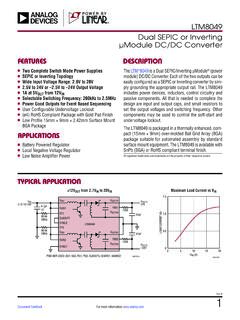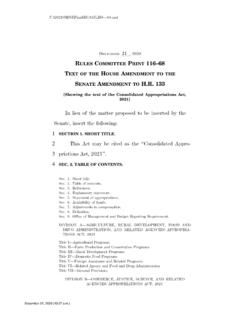Transcription of GENDER MAINSTREAMING Training Manual - The Compass …
1 GENDER MAINSTREAMING Training Manual USAID Zambia Community HIV Prevention Project (USAID Z-CHPP) December 2017 pact is a promise of a better tomorrow for all those who are poor and marginalized. Working in partnership to develop local solutions that enable people to own their own future, pact helps people and communities build their own capacity to generate income, improve access to quality health services, and gain lasting benefit from the sustainable use of the natural resources around them.
2 At work in more than 30 countries, pact is building local promise with an integrated, adaptive approach that is shaping the future of international development. Visit us at December 2017. Disclaimer: This guideline is made possible by the generous support of the American people through the United States Agency for International Development (USAID) and the President s Emergency Plan for AIDS Relief (PEPFAR). The contents of this guide are the sole responsibility of pact and Plan International and do not necessarily reflect the views of USAID, PEPFAR, or the United States Government.
3 Recommended citation: Zambia Community HIV Prevention Project (Z-CHPP). 2017. GENDER MAINSTREAMING Training Manual . Lusaka, Zambia and Washington, DC, USA: pact . Contact: Phesheya Vilakazi Program Manager pact 1828 L Street NW, Suite 300 Washington, DC 20036 202-466-5666 Jackson Thoya Chief of Party pact Zambia Plot 35186, Block A, Alick Nkhata Road, Lusaka, Zambia +260 (211) 254 089/91 ii Table of Contents .. ii Overview of the USAID Zambia Community HIV Prevention Project (USAID Z-CHPP).
4 1 Background to the Training Guide .. 2 Facilitation Skills .. 3 Overview of Training Modules .. 8 This Training guide is organized into seven modules: .. 8 How to Use the Training Guide .. Error! Bookmark not defined. Module 1: Introduction .. Error! Bookmark not defined. Module 2: GENDER Terminology and Concepts .. Error! Bookmark not defined. Trainer Tips for Module 2 .. 17 Module 3: The Social Construction of GENDER .. Error! Bookmark not defined. Trainer Tips for Module 3 .. 26 Module 4: GENDER and HIV Linkages.
5 Error! Bookmark not defined. Module 5: Sexual and GENDER -Based Violence .. Error! Bookmark not defined. Module 6: GENDER Analysis Frameworks and Tools .. Error! Bookmark not defined. Module 7: Action Planning and Commitments .. Error! Bookmark not defined. Annexes .. Error! Bookmark not defined. Handout 1: Z-CHPP GENDER MAINSTREAMING Training Guide .. 1 Handout 2: GENDER -Related Terminology .. 2 Handout 3: GENDER Concepts .. 6 Handout 4: GENDER and HIV .. 9 Handout 5: Violence and HIV .. 14 Handout 6: The Story of Stellah and Banji Case Study.
6 18 Handout 7: Examples of SGBV .. 19 Handout 8: Five Domains of GENDER Analysis Matrix .. 20 Handout 9: Action Plan for GENDER MAINSTREAMING .. 21 Handout 10: GENDER MAINSTREAMING Training Evaluation .. 22 Table of Contents 1 The United States Agency for International Development (USAID)/President s Emergency Plan for AIDS Relief (PEPFAR)-funded Zambia Community HIV Prevention Project (Z-CHPP) is a five-year cooperative agreement led by pact to accelerate progress towards Zambia s goal of reducing new HIV infections.
7 The project supports Zambia to reach the United Nations Program on HIV (UNAIDS) 2020 goal of having 90% of all people living with HIV (PLHIV) know their status, 90% of those who know their HIV positive status receiving sustained anti-retroviral therapy (ART), and 90% of those on ART achieving viral suppression. To accomplish its goal, Z-CHPP will increase the adoption of high-impact HIV services and protective behaviors among at-risk populations using evidence-based and locally owned solutions. Z-CHPP has four specific objectives: 1.
8 Key determinants of risky behavior mitigated among priority populations; 2. Increase in completed referrals from community programs to high impact services; 3. Actions adopted by communities to reduce young women s vulnerability to HIV, unintended pregnancy, and sexual and GENDER -based violence (SGBV); and 4. Strengthened capacity of local stakeholders to plan, monitor, evaluate, and ensure the quality of prevention interventions. Z-CHPP maximizes the impact of USAID resources by focusing where the greatest gains can be achieved: in high-prevalence districts, especially those that are densely populated; targeting populations at high risk of infection or infecting others; and tailoring approaches to different segments of the population.
9 Activities are implemented directly by pact and its core international partner, Plan, as well as by local partners through sub-grants. This approach leverages existing relationships at the community level by engaging and supporting traditional and religious leaders, community-based service providers, and the decentralized government structures. Z-CHPP implements activities in 25 priority districts across Lusaka, Central, Copperbelt, Western, North Western, and Southern provinces.
10 Within each district, Z-CHPP aims to achieve a high saturation of interventions, focusing first on rapid scale-up of HIV testing services (HTS) and reaching PLHIV who are outside of the treatment cascade, then expanding the coverage and scope of activities with a comprehensive package of interventions to reach priority high-risk populations, specifically: Adolescent girls and boys (ages 10-19 years); Young women and men (ages 20-24 years); PLHIV; Sero-discordant couples; and Other priority populations, including male sexual partners of adolescent girls and young women (AGYW), cane cutters, miners, fish traders, long-distance truck drivers, and other migrant workers.








